Contents
Margelan radish, although grown in Our Country, is not widely distributed compared to radish and daikon. Meanwhile, the root crop has been cultivated for centuries in the Central Asian countries, formerly the former republics of the Soviet Union. It even got its name in honor of the Uzbek city of Margilan, located in the Ferghana Valley, where it came from China.

Description of Lobo radish
When describing the green Margelan (Chinese) radish, a lot of confusion and inaccuracies are allowed. Perhaps that is why the culture has not become widespread – gardeners plant it, and the harvest does not meet their expectations.
The extensive genus Radish belongs to the Cabbage (Cruciferous) family, one of the species of which is Sowing Radish. The plant originates from Asia, where it has been grown for thousands of years and is not found in the wild. The taxon includes the well-known radish, daikon, lobo (forehead), black radish, oilseed radish and a number of other subspecies.
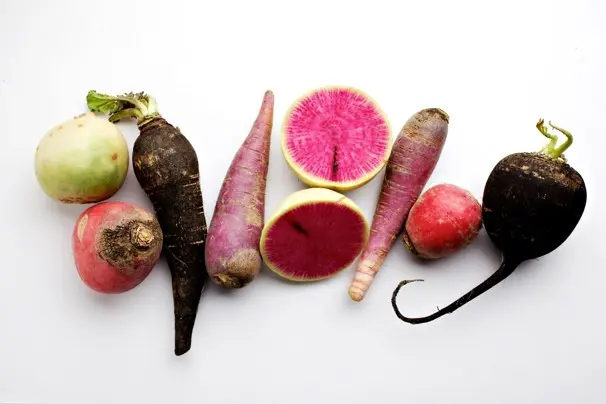
The Latin name for lobo is Raphanus sativus L.convar. lobo Sazon. et Stankev. var. lobo. Only a narrow specialist can remember this, but it is enough for ordinary gardeners to know that the culture, in terms of taste properties, occupies an intermediate position between radish and daikon. But it differs significantly from both subspecies. You should not expect early ripeness of radishes from lobo or gigantic size and complete absence of bitterness, like daikon. This is an independent culture that differs from others in taste, external signs and cultivation features.
Lobo was described in 1971 as a group of varieties. In 1985 it was classified as a variety of Common Radish. Since then, 25 varieties have been included in the State Register of Our Country, the most famous are the Fang of the Elephant and Margelanskaya.
What is the difference between daikon and lobo
Often the Chinese lobo radish is confused with the Japanese – daikon. Even seed producers sometimes mislead gardeners. Of course, cultures are similar, but not identical. Their main differences:
- in daikon, root crops are much larger than in lobo, their weight often exceeds 500 g;
- the growing season of the Chinese radish is longer than that of the Japanese;
- the taste of lobo is spicier compared to daikon;
- Chinese radish has wide leaves, while Japanese radish has narrow leaves.
Description of the variety of Chinese radish Lobo Margelanskaya
In 2005, the Moscow enterprises “Company Lance” and “Agrofirm Poisk” filed an application for registration of the radish variety Lobo Margelanskaya. In 2007, the culture was accepted by the State Register and recommended for cultivation throughout Our Country in private farms.
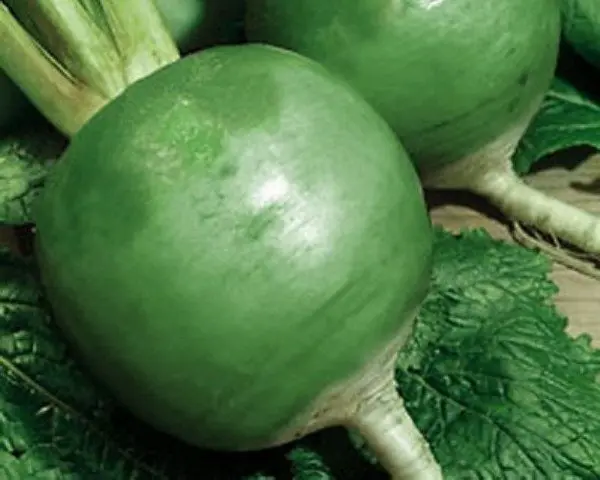
Margelanskaya is a mid-season long-term storage radish, which takes 60-65 days from the moment of emergence of full shoots to the start of harvest.
Margelan radish forms a rosette of erect leaves of medium size, obovate, with a serrated edge, yellow-green in color. The root crop of this variety is elliptical, with a rounded head, completely green or partially white.
As you can see in the photo, the Margelan radish has white flesh. It tastes juicy, sweetish, with a slight bitterness. One root crop weighs 250-300 g, the average yield is 3-3,3 kg per square meter. m.
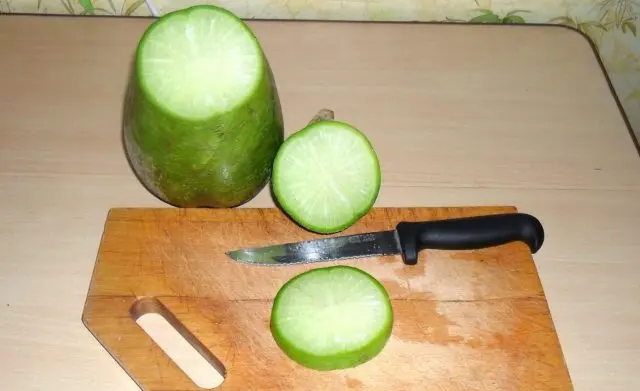
Varieties of Margelan radish
Margelan radish has no varieties – it is a variety itself. But the lobo – the original variety has them. Only in the State Register, as of 2018, 25 varieties were registered. In addition to the well-known Fang of the Elephant and Margelanskaya, there are root crops:
- whose weight exceeds 500 g or does not exceed 180 g;
- with red, pink, white, green flesh and skin;
- cylindrical, round, similar in shape to a turnip;
- with a sweetish taste, almost imperceptible or pronounced bitterness;
- intended for immediate consumption or stored for up to four months.
Fang of an elephant
This variety of lobo is often confused with daikon. The elephant’s tusk was registered in 1977, the seed-growing association “Sortsemovoshch” acted as the originator. The variety is recommended for cultivation in all regions.

An elephant’s tusk is a cylindrical root crop, the average length of which is 60 cm. It rises 65-70% above the ground and weighs about 0,5 kg. The root surface is smooth, white, sometimes with light green transitions. The pulp is sweet, crispy, juicy, with a slight bitterness.
Not only root crops are edible, but also young radish leaves, in which bitterness is more pronounced and contains many vitamins.
The Elephant’s Fang variety is mid-season, the radish begins to be harvested 60-70 days after germination. Productivity is high, 1 square. m gives 5-6 kg of root crops.
Elephant’s Fang is a variety unsuitable for long-term storage.
Ruby Surprise
The variety was accepted by the State Register in 2015. The originator was Agrofirma Aelita LLC, the authors are Kachaynik V. G., Gulkin M. N., Karmanova O. A., Matyunina S. V.
Ruby Surprise reaches technical maturity in 60-65 days. Forms a slightly drooping rosette and a short round white root crop with a green spot at the leaves. Its average weight is 200-240 g. The flesh is red, juicy, with a pleasant taste. Productivity – up to 4,3 kg per sq. m. Radish is suitable for short-term storage.
The variety Ruby Surprise has been granted a protective patent, which expires in 2045.

Severyanka
One of the largest varieties of lobo is Severyanka, adopted by the State Register in 2001. The originator was the Federal Scientific Center for Vegetable Growing.
The variety is early ripe, 60 days after the emergence of seedlings, you can harvest. A pink or almost red root vegetable, if you do not take into account the size, it is similar to a radish. It just weighs 500-890 g. The leaves of Severyanka are semi-raised, the root crop is round, flattened, with a sharp tip. The pulp is juicy, white, the taste is pleasant, with pronounced sweetness and sharpness. Productivity from 1 square. m – 3-4,8 kg.
Variety Severyanka is considered not only very large, but also one of the most delicious. It withstands the harsh climate of the Northwest better than others, although it also grows without problems in other regions. Severyanka is intended for autumn-winter consumption. It keeps better than Elephant’s Tooth or Ruby Surprise, but it won’t last all winter even in the most suitable conditions.
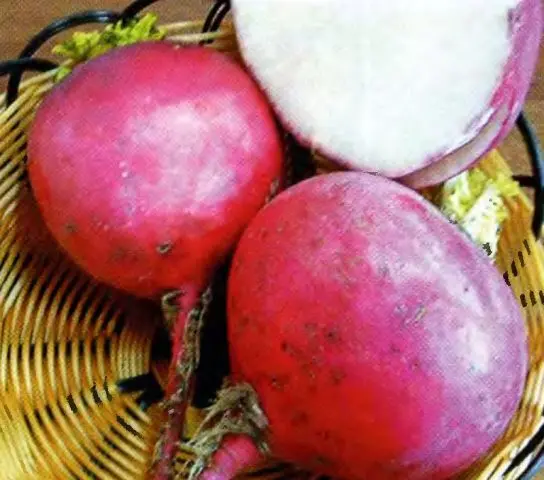
Planting Margelan radish
Growing and caring for Margelan radish is simple. But if the seemingly simple rules are not followed, it always ends in failure. Everything matters – the timing of planting Margelan radish, water regime, soil preparation. Failure at any stage will result in arrowheads or the formation of a small root crop, often hollow or bitter.
When to plant Margelan radish
Growing green radish in the open field is not difficult, but many gardeners manage to ruin the planting by simply not meeting the deadlines. For some reason, they are guided by crops such as daikon, or, even “better”, radish.
Yes, these are all short daylight plants. They start up a flower arrow, without waiting for the growth of the root crop, if it is illuminated for more than 12 hours a day. But radish has a short vegetative period, when sown in the spring, it manages to ripen safely. Daikon needs more time to grow a root crop; with early planting, it rarely reaches technical ripeness everywhere except in the southernmost regions of Our Country and Ukraine.
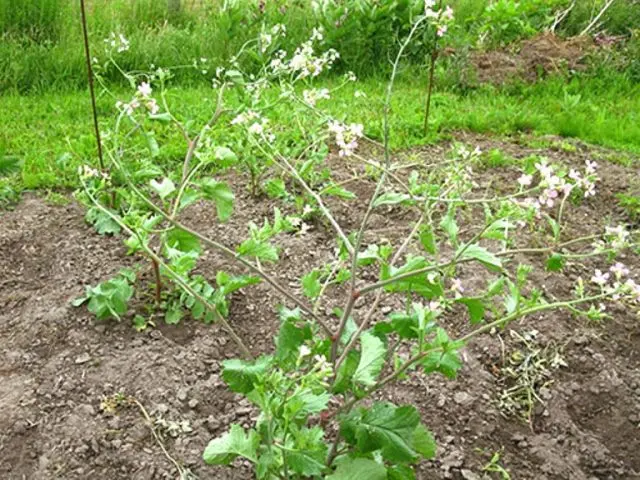
Green radish and lobo varieties of any ripening period in the spring should not even be sown. When the soil warms up enough for the seeds to germinate, the day will lengthen so much that there is simply no time left for the development of the root crop. Too much time passes from germination to technical maturity. Someone may object that in Central Asia the Margelan radish has always been sown in two passes. Moreover, spring planting gave root crops for summer consumption, and autumn – for winter. But the climate is different there, the earth warms up early, and the difference in the length of the day in different seasons is smoothed out.
So the cultivation of Margelan radish in Our Country, Ukraine and Belarus is possible in open ground only with late summer sowing. With a sudden drop in temperature, the culture usually ripens even in the North-West – lobo endures short-term frosts. Before the onset of stable cold weather, the Margelan radish manages to gain weight.
The crop is sown in most regions from mid-July to early August. In the North-West, you can do this a little earlier, in the southern regions – a little later.

Soil preparation
The soil for the Margelan radish is dug deep, though not as much as for the White Fang variety. Although its root crop rises 2/3 above the soil level, this does not always happen. If the ground is dense, it can “stick out” no more than half. Yes, and a long tail, covered with small sucking roots, needs to grow somewhere. It is he who delivers most of the moisture and nutrients to the radish, if you limit its development, the root crop will be small.
It is better to prepare the soil in advance – dig up at least two weeks before sowing the radish so that it can “breathe” and sag a little. You can add sand, ash, leaf humus or peat to the soil to improve the structure. Humus is added in the fall, if you do this before sowing radish, it will receive an excess amount of nitrogen. This may have the following consequences:
- the aerial part will actively develop to the detriment of the root crop;
- voids form inside the radish, the flesh coarsens;
- the taste from overfeeding with nitrogen in root crops becomes worse;
- nitrates accumulate in the radish;
- roots spoil quickly.
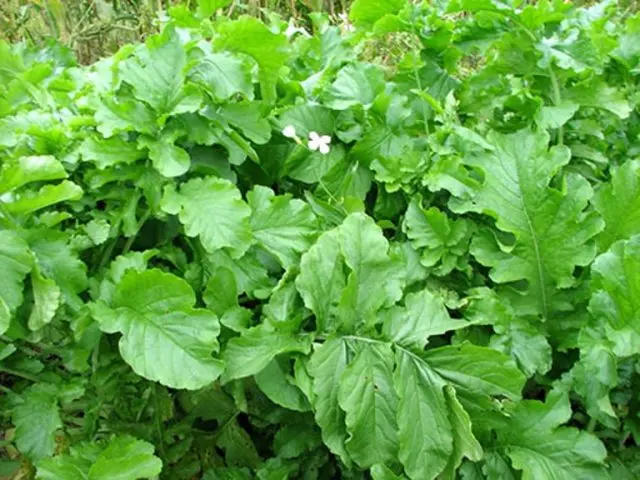
Compost should also not be introduced into the soil before sowing radishes, unless it has matured well with the help of special means, or has been aged for at least 3 years. Fresh has a lumpy tight structure, which is not suitable for the culture – it interferes with the development of the root crop.
Since sowing is done in the second half of summer, something should already grow in the place intended for Margelan radish. In the spring, you can plant early potatoes, peas for fresh consumption, winter or onions intended for greens. It is impossible to grow other cruciferous plants before radishes – early radishes or cabbage, lettuce, mustard.
Sowing Rules
Margelan radish is usually sown in nests located in rows at a distance of 15-20 cm from each other. 30-40 cm are left between the rows. Each nest is filled with a mineral complex fertilizer (better intended for root crops), mixed with the soil and watered abundantly.
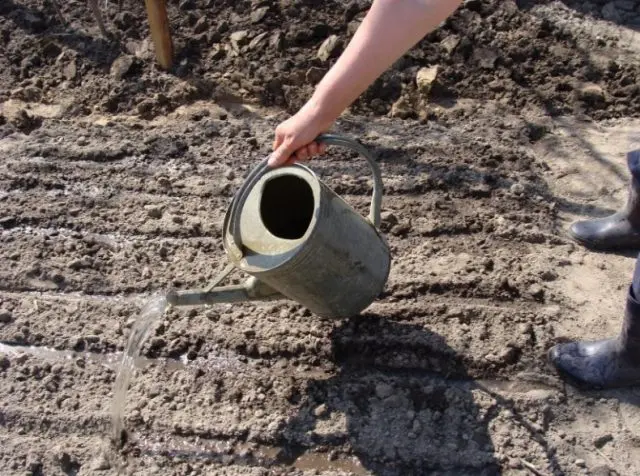
2-3 seeds are planted in each hole, and if there is doubt about their germination – 3-4. Dry soil is poured on top with a layer of 1,5-2 cm. Additional watering is not needed.
To make the seeds sprout faster, you can cover the planting with a film. But even without additional measures, the first shoots will appear in about a week. When 2-3 real leaves appear, 1 strongest sprout is left in each nest, the rest are pulled out.
You can sow seeds in furrows. But then, when thinning, more seedlings will have to be removed.
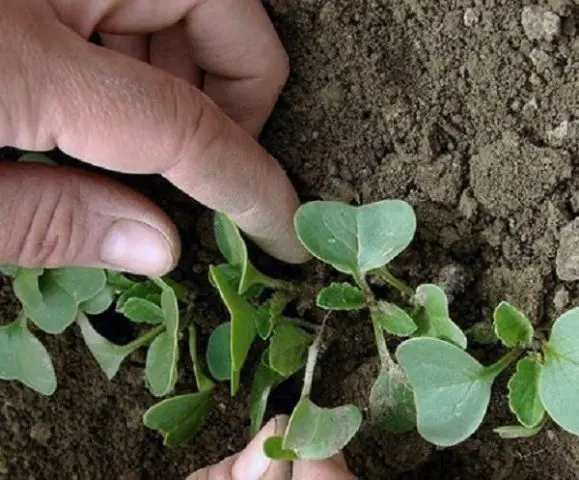
How to grow Margelan radish
Care when growing green radish is to remove weeds, loosen row spacing and timely watering. The culture loves moisture, overdrying can kill young sprouts, and when forming a root crop, it will cause it to coarsen, form voids, reduce size and worsen taste. The soil under the Margelan radish should always be moist, but not wet.
A culture takes a long time from germination to technical maturity. You can do without top dressing only on fertile soils that have been well fertilized since autumn and when planting. In other cases, the radish is fertilized twice – the first time immediately after thinning, the second – when the root crop becomes noticeable, and it will already be possible to determine its color.
When planting seeds in furrows, a second thinning will be required, 10-12 days after the first. It must be remembered that the Margelan radish forms a rounded root crop, growing not only in depth, but also in breadth. The distance between plants should be at least 15 cm.
All yellowed, drooping to the ground and shading the root crop are cut off. This will not only improve the quality of the radish, but also protect it from shooting at high temperatures.
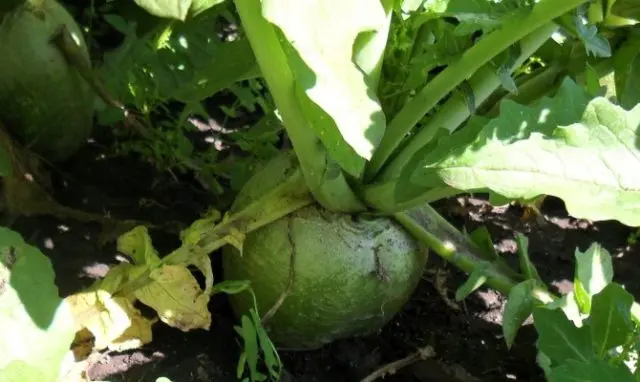
Pests and diseases: control and prevention measures
Margelan radish rarely gets sick. Problems arise only with systematic overflows, especially on dense soils – then various rots appear on the plant.
But insects constantly annoy culture – it is susceptible to damage by all cruciferous pests. The problem for the Margelan radish is:
- slugs, which can be fought by scattering metaldehyde between the bushes, and as a preventive measure, cut off the leaves that fall to the ground;
- cruciferous flea, which can be prevented by scattering ash or tobacco dust on the ground and radish leaves after watering, or spreading wormwood between the rows.

When the green radish is removed from the garden
Margelan radish for food can be torn without waiting for technical ripeness as needed, as soon as the roots grow a little. They will taste great. The timing of harvesting Margelan radish from germination is usually indicated on bags of seeds, on average they are:
- in early varieties – 55-65 days;
- for mid-season and late – from 60 to 110 days.
A delay of several days with the harvest does not play a role. But if you are late for a long time, the pulp can coarsen, voids form in the root crop.
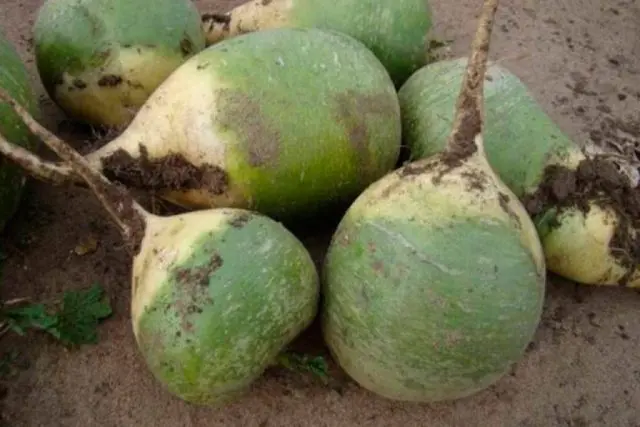
Although the Margelan rare can withstand short-term frosts, it must be collected before the onset of a stable temperature drop to 0⁰ C or less. If you overexpose the root crops in the garden, they will be stored worse.
On sandy soils, the radish can simply be pulled out of the ground. On chernozems and dense soils, it is dug up.
When to clean the Margelan radish for storage
Immediately after harvesting from the radish, you need to shake off the soil and remove the extra thin roots, if necessary, using a soft cloth. It is impossible to clean them off with a knife, since even slightly scratched root crops will not be stored. Then a rejection is carried out – all even slightly damaged Margelan radish must be eaten or processed.
Before storing, the tops are removed, leaving 1-2 cm of petioles. Beginning gardeners cut them, but it is better to carefully unscrew the “extra” leaves. You can work out on a radish intended for immediate consumption.
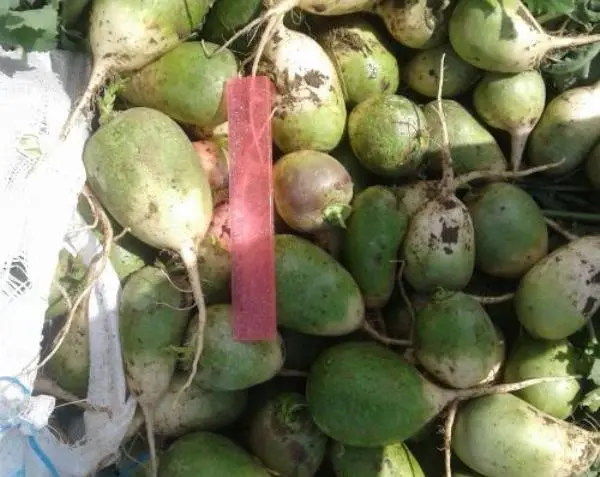
Storage Rules
Although the Margelan radish is considered intended for long-term storage, it will not lie until spring. The maximum that can be achieved even if all the rules are observed is four months. And then at the end of storage, the Margelan radish will be somewhat lethargic, insipid, and will also lose most of the vitamins and minerals. Without significant changes, root crops can lie for a month.
The best conditions for winter maintenance are a dark place, temperature from 1⁰ to 2⁰ C, humidity 80-95%.
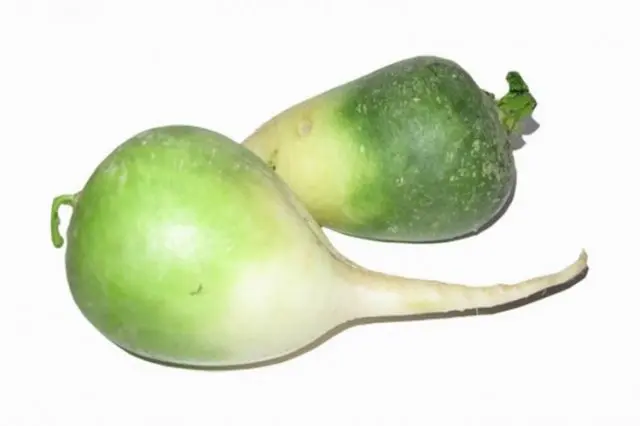
How to store Margelan radish in winter in the cellar
It is best to store root crops in moist sand, arranged in wooden boxes. Subject to the temperature regime and the recommended humidity, they can be ready for use up to 4 months. But if at least one damaged root gets into the box, it will begin to rot and ruin everything lying nearby.
How to store Margelan radish at home
Root vegetables can be stored in the refrigerator for up to 30 days. They are laid out in plastic bags and kept in a vegetable box.
Conclusion
Margelan radish is a healthy and tasty root crop that can diversify the diet in the cold season. It can be easily grown on your own if you know and follow the requirements of the culture.









